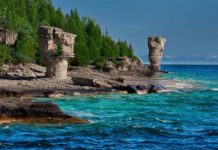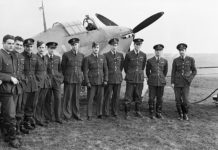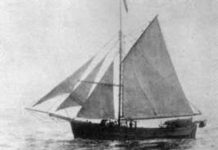August 15, 1910. The cover of the five-cent copy of The Vancouver Daily Province featured a cartoon titled All Aboard for the Exhibition. In it a beaver holding a baton led an Edwardian family of four to Happyland. No, not a cult theme park, but the forerunner of the Pacific National Exhibition.
Edwardian Transportation
Many of the 4000 first-day visitors rode one of the eight special C.P.R. trains that ran along both Powell and Hastings for 25 cents roundtrip. The Powell Street run offered fine views of the steamships and square-riggers in the inlet as well as the densely forested slopes of North Vancouver.
Showing up in one of those newfangled contraptions called automobiles cost 50 cents for the driver and each passenger. You could also reach the fair by the steamship Hamlin which plied the route between downtown and Hastings Park, or by the new extension of the B.C. Electric Railway tramline.
By any measurement, Happyland was the social event of the season. It had been in the planning for three years. Hastings Park had been cleared and developed. The racetrack had been there since 1905, but a 10,000-seat grandstand had been built as well as a track and field venue in the middle of the racing oval.
A glass-domed edifice named the Industrial Building as well as a smaller structure called the Machinery Hall housed the exhibits. As their names suggest, these featured the latest in technology. Fairgoers could examine the Walworth Ralston company’s wagons, buggies, light vehicles, and cream separators, gas engines from Stancliffe & Co., a display of gas lights from the Moore Light company.
Vancouver was 24 years old and developing fast. That year Charles K. Hamilton made the first airplane flight west of Winnipeg before 3500 spectators in Richmond’s Minoru Park. He later challenged a horse to a mile race and lost by ten seconds.
Baden Powell
On opening day, Vancouver Exhibition Association President J.J. Miller escorted General Sir Baden Powell through the various exhibits. Powell was a hero of the Boer War and the originator of the Boy Scouts movement. His lads “marched into the ground at three o’clock, the youthful soldiers learning, as their commander said, how to be good citizens rather than perfect military machines, made a splendid impression and were greeted with rounds of cheers”.
As for food, you could eat peanuts and popcorn or drink lemonade and soda pop, but no booze. If the sudden urge to send a card or letter overtook you there was a post office on the grounds, and if you ran short of cash there was a branch of the Royal Bank on site for withdrawals.
The fair did have some risqué elements, including burlesque shows, Turkish dancing girls, a petrified woman, a Ganges River crocodile, boxing and wrestling, and a diving tower 75 feet high above a “pool of water covered by flaming gasoline”.
Ferris Wheel
By 1914 there was a carousel and a twelve-tub ferris wheel and, in 1915, the Dip the Dips, as the rollercoaster was then known. The grandstand featured free vaudeville acts including Frank and True Rice and the Hayrick Rubes, billed as “a hurricane of hilarity”.
The six-day fair had daily themes. Monday was Preparation day, Tuesday honoured Sir Wilfred Laurier who would arrive in one of the B.C. Electric Company’s observation cars to formally open the Exhibition. Wednesday was Children’s and Ladies’ day, featuring performances by “Educated dogs, a troupe of acrobats and several theatrical acts…” Thursday was Merchant’s day, Friday was American day, and Saturday was Labour day given over to the various trades and athletics.
The director of the Dog Show noted that 220 dogs of 30 breeds took part. The only sombre note regarded a certain Mrs. Gouge whose “Promeranian (sic) Duchess broke its chain and escaped. The dog was immediately followed by a friend of Mrs. Gouge’s who saw it get on an electric car and followed in one immediately afterwards. The dog jumped from the car inside the city limits and was lost”.
The aims of the Vancouver Exhibition Association’s eight-point constitution included the “promotion of trade and commerce, the stimulation of healthy rivalry for supremacy and excellence in the minds of the rising generation, and the encouragement of the cultivation of the beautiful in nature and art”.
For all this high-minded sentiment, Happyland reflected the values of its time.
The Daily News-Advertiser noted that: “Most ingenious of all the schemes now in operation is that now doing business on the south road. Here a dusky negro sits on a board fixed to an iron bar, directly over a pool of water. A baseball thrown at a target above this son of Ham’s head, springs a trap, and allows the seat on which this black man sits to move backward, throwing the occupant head-foremost into the water. This device is now one of the most popular on the Road. Not only the person throwing the ball but every one about gets a share of the amusement.”
Wilfred Laurier
Prime Minister Wilfred Laurier officially opened the fair but the newspapers were less interested in his opinion of the candy apples than in his hour-long speech “explaining his position on the question of Asiatic immigration.” A delegation representing organized labour demanded the total restriction of Asiatic immigration, “on the ground that the supremacy of the whites could not be continued here if existing conditions were allowed to maintain.”
The lean and woolly-haired Laurier agreed with the aims but advocated friendly diplomacy instead of hostile legislation. Then he boarded a train and slipped away Back East.
Despite the dire prognostications there was no shortage of employment in those days. Many found work at Happyland, including William Pratt, a carpenter recently arrived from England. He eventually decided that banging nails in Vancouver wasn’t for him so moved on to Hollywood and changed his name to Boris Karloff.







